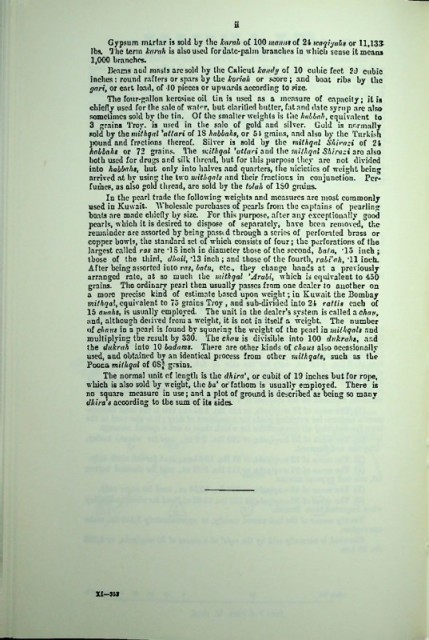Page 400 - 3 Persian Trade rep KUWAIT 1_Neat
P. 400
Gypsum mtrfar is sold by the karah of 100 manns of 21 icaqiyahs or 11,135
lbs. The term karah is also used for date-palm branches in which sense it means
1,000 branches.
Beams and masts arc sold by the Calicut kandy of 10 cubic feet 20 cubic
inches: round rafters or spars by the koriah or score; and boat ribs by the
gari, or cart load, of 10 pieces or upwards according to size.
The four-gallon kcrosinc oil tin is used as a measure of capacity; it is
chiefly used for the sale of water, but clarified butter, fat and date syrup arc also
sometimes sold by the tin. Of the smaller weights is the habbah, equivalent to
3 grains Troy, is used in the sale of gold and silver. Gold is normally
sold by the nixthqal *atlari of IS habbalxs, or 51 grains, and also by the Turkish
pound and fractions thereof. Silver is sold by the mithqal Shivazi of 21
habbahs or 72 grains. The milhqal ’atlari and the mithqal Shirazi arc also
both used for drugs and silk thread, but for this purpose they are not divided
into habbahs, hut only into halves and quarters, the nicictics of weight being
arrived at by using the two mithqals and their fractions in conjunction. Per
fumes, as also gold thread, are sold by the tolah of ISO grains.
In the pearl trade the following weights and measures arc most commonly
used in Kuwait. "Wholesale purchases of pearls from the captains of pearling
boats are made chiefly by size. l?or this purpose, after any exceptionally good
pearls, which it is desired to dispose of separately, have been removed, the
remainder are assorted by being passed through a series of perforated brass or
copper bowls, the standard set of which consists of four; the perforations of the
largest called ras are *15 inch in diameter those of the second, bafn, *15 inch ;
those of the third, dhail, *13 inch; and those of the fourth, ralVah, *11 inch.
After being assorted iuto ras, bain, etc., th^y change hands at a previously
arranged rate, at so much the mithqal *Arabi, which is equivalent to 450
grains. The ordinary pearl then usually passes from one dealer to another on
a more precise kind of estimate based upon weight; in Kuwait the Bombay
mithqal, equivalent to 75 grains Troy , and sub-divided into 21 rattis each of
15 anahs, is usually employed. The unit in the dealer’s system is called a chav,
and, although derived from a weight, it is not in itself a weight. The number
of chav8 in a pearl is found by squaring the weight of the pearl in mithqals and
multiplying the result by 330. The chau is divisible into 100 dukrahs, and
the dukrah into 10 badams. There are other kinds of chaus also occasionally
used, and obtained by an identical process from other mithqals, such as the
Poona mithqal of GSJ- grains.
The normal unit of length is the dhira*, or cubit of 19 inches but for rope,
which is also sold by weight, the ba’ or fathom is usually employed. There is
no square measure in use; and a plot of ground is described as being so many
dhira's according to the sum of its sides.
XI—351

